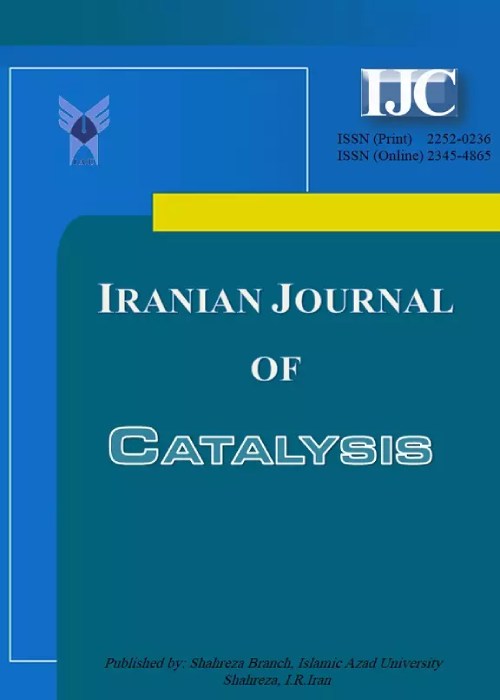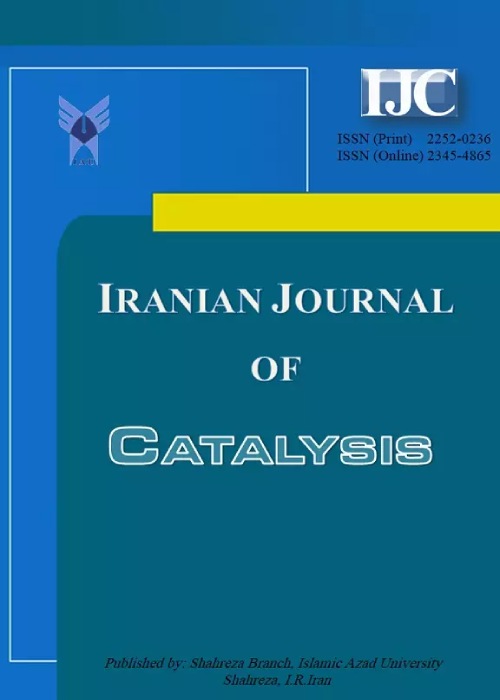فهرست مطالب

Iranian Journal of Catalysis
Volume:12 Issue: 4, Autumn 2022
- تاریخ انتشار: 1401/11/30
- تعداد عناوین: 9
-
-
Pages 399-405In this study, a vapor permeation-integrated heterogeneous catalytic esterification reaction was investigated to improve the ester conversion of propionic acid and isopropanol. The reaction was carried out using Amberlyst 15 (Rohm & Haas) as a catalyst with different weight fractions of 3%, 4%, 10%, and 12% wt. relative to propionic acid. A hydrophilic PERVAP®2201 membrane (Sulzer) was used to remove water vapor from the glass reactor. Different molar ratios (1:1, 1.5:1, and 3:1) of alcohol to acid were used in the feed mixture. Applying the coupled membrane system, using 12wt.% of catalyst, increased the acid conversion from 39% (when no membrane was employed) to nearly 90% for three hours after the beginning of the process.Keywords: reaction, Isopropyl Propionate, PERVAP®2201, Heterogeneous catalyst
-
Pages 407-416
A highly efficient, eco-friendly procedure has been proposed for the synthesis of 2-amino-3-phenylsulfonyl-4H-pyran derivatives via nano-cellulose-OSnCl4-x catalyst prepared from cotton as support treated with tin tetrachloride (SnCl4). This catalyst is characterized by FT-IR, FESEM, TEM, TGA, and EDX. The TEM results confirmed the size of the nano-cellulose-OSnCl4-x catalyst was below 30 nm. The efficiency of this solid acid catalyst was investigated in one-pot, three-component condensation reactions with aromatic aldehydes, dimedone, and phenylsulfonylacetonitrile under reflux conditions. As a result, 2-amino-3-phenylsulfonyl-4H-pyran derivatives were produced under facile conditions in high yield (84-95%) and high rate (30-50 min) using nano-cellulose-OSnCl4-x as a recyclable catalyst.
Keywords: Phenylsulfonylacetonitrile, Pyran derivatives, Dimedone, green chemistry, nano-cellulose-OSnCl4-x -
Pages 417-429Densely functionalized 3,4-dihydropyridones were synthesized by a four-component reaction of Meldrumʼs acid, ethyl acetoacetate, ammonium acetate, and proper aromatic aldehydes in the presence of novel organic-inorganic cobalt incorporated magnetic nanocatalyst (γ-Fe2O3@HAp/Co(II)) using ethanol as a green solvent at reflux condition. This new synthetic method provided the target compounds in a high yield (70-95%) and lower reaction time (20-75 min). The protocol benefits from the high purity of the products, environmentally friendly, milder reaction conditions, recyclability of the catalyst, and facile workup procedure. The structure of the synthesized novel nanocatalyst was confirmed by FT-IR, XRD, FSEM, TEM, EDS, and TGA analyses. The catalyst was used in eight cycles without any notable variation in catalytic activities.Keywords: 4-Dihydropyridone, One-pot, Four-component, Meldrumʼs acid, Nanocatalyst, γ-Fe2O3@HAp, Co(II)
-
Pages 431-438The selective oxidation of olefins is a key academic and industrial research challenge. Herein, silver was supported on mesoporous silica through a facile synthesis procedure, and characterized using various technics such as FT-IR, XRD, SEM, BET, and EDX. This efficient separable agent alongside aqueous H2O2 was applied to the oxidation of various olefines (1-octen, 1-hexene, cyclohexene, cyclooctene, styrene, and 1, 2-diphenylmethane) to 1, 2-diol under mild reaction conditions (65 ℃) with high conversion and excellent selectivity. The promoter exhibited excellent reusability and stability in the reaction medium.Keywords: Mesoporous silica, Silver, selective oxidation, 1, 2-diol
-
Pages 439-450SO4/ZrO2 heterogeneous acid catalyst was prepared by wet impregnation method from ZrO2 precursor involved variations in H2SO4 concentration (0.5; 1.0; 1.5 M) and calcination temperature (400, 500, 600 ℃) to yield catalyst with the highest acidity value. The catalysts produced were characterized using Fourier Transform Infrared (FTIR) spectrometer, X-Ray Diffractometer (XRD), Scanning Electron Microscope-Energy Dispersive X-Ray (SEM-EDX), Thermogravimetry and Differential Scanning Calorimeter (TGA-DSC), Gas Sorption Analyzer (GSA), and acidity test using the gravimetric method with ammonia vapor. The catalyst used to observe activity and selectivity in the dehydration reaction of ethanol to diethyl ether (DEE) was SO4/ZrO2 catalyst with the highest total acidity. The liquid product from the dehydration of ethanol was analyzed using Gas Chromatography (GC). The ZS‐1.5‐500 catalyst showed the best activity and selectivity in the dehydration reaction of ethanol to DEE at a temperature of 225 ℃, yielding 49.85% (w/w) ethanol conversion and a 1.62% DEE selectivity.Keywords: Ethanol dehydration, diethyl ether, Optimization, Catalysts, Sulfated Zirconia
-
Pages 451-461In this work, chitosan biopolymer was cross-linked by starch oxide through the covalent bond formation between amine groups of chitosan and aldehyde functional of oxidized starch. A magnetic bio-support was obtained due to the treatment of the produced hybrid biopolymer with iron oxide nanoparticles. As a result of exposing of silver nitrate salt to magnetic polymer, silver ions (Ag2O) and also Ag metal nanoparticles were deposited on this bio-support. The silver oxide was decorated on the magnetic chitosan biopolymer could catalyzed the cross-coupling reaction of substituted benzaldehydes with phenylacetylene in the presence of PPh3 (20 mol%) in water to achieve 1,3-diphenyl-2-propyn-1-ol derivatives in good yields at proper reaction times.Keywords: Chitosan supported catalysts, Magnetic Chitosan, Silver catalyzed coupling reaction, 3-diphenyl-2-propyn-1-ol
-
Pages 463-474In this work, diisopropyl ether (DIPE) was produced through catalytic dehydration of isopropanol over zirconium phosphate-modified phosphate modified natural zeolite. The catalyst was prepared via the wet impregnation method. They were tested at 150 ˚C for 3 hours under a reflux system. The effect of zeolite-Zr(H2PO4)4 metal loading and zeolite-Zr without phosphate incorporation on dehydration isopropanol was also assessed. The results showed the natural zeolite was successfully modified as confirmed by XRD, FTIR, SEM-EDX, N2 physisorption, and catalyst acidity by the gravimetric technique. The highest isopropanol conversion (66.73%) was accomplished by 8 mEq/g zeolite-Zr(H2PO4)4 followed by the DIPE yield and selectivity up to 35.81% and 47.8%, respectively. Further reusability investigation showed that zeolite-Zr(H2PO4)4 catalyst provided adequate reusability up to the fourth reused with relatively decreased catalytic activity towards isopropanol dehydration.Keywords: isopropanol conversion, diisopropyl ether, zeolite, Modification, zirconium phosphate
-
Pages 475-487The molecularly dispersed BiP1-xVxO4/TiO2 supported materials, with x varying from 0 to 1, were prepared by impregnation of Bismuth, Phosphorus, and Vanadium on a Titanium Oxide TiO2 support. Their structures were characterized by different techniques including X-ray diffraction, Spectroscopic Raman, temperature-programmed reduction of the catalysts in H2 (H2-TPR), and by the methanol oxidation reaction. This very sensitive technique provided us with relevant information on the nature of the catalytic active sites (acid-base and redox) of the phases dispersed on the support. The characterization results show the structural evolution of BiP1-xVxO4 species, from isolated BiPO4 crystallites for x =0, to BiVO4 crystallites x =1. The oxidation of methanol showed the acidic properties of the BiPO4/TiO2 catalyst, through the formation of dimethyl ether as the major product of the reaction. The substitution of phosphorus by vanadium promotes the formation of formaldehyde, confirming the presence of redox sites. These catalysts were examined in the oxidative dehydrogenation (ODH) of propane to propene. For x > 0.5, dispersed BiVO4 exhibited higher levels of propane ODH than BiPO4 crystallites, consistent with their greater reducibility probed by temperature-programmed reduction of H2 and the presence of redox sites confirmed by methanol oxidation, with good selectivity to propene. Catalysts with x = 0, were less selective to propene due to favorable propylene combustion during its formation. A thorough understanding of the intrinsic catalytic properties of the BiP1-xVxO4/TiO2 oxides and in particular the BiPO4 and BiVO4 crystallites provides relevant information on the structural requirements of the propane ODH reaction, of interest for the design of more efficient Bi-P-V-O based catalysts for propene production. The results show that all substituted catalysts exhibit significant propene selectivity. In addition, the BiP0.7V0.3O4/TiO2 catalyst exhibits high activity with good propene selectivity. This catalytic activity was correlated with high reducibility.Keywords: BiP1-xVxO4, TiO2 catalyst, methanol oxidation, Propane oxidative dehydrogenation
-
Pages 489-492Acetic acid and its derivatives are very important materials with significant applications in both the industrial and academic communities. These are used in various industries especially food and pharmaceutical industries, due to their non-toxicity as pH regulators, catalysts and preservatives in food products.In recent years, ionic liquids (ILs) and molten salts (MSs) with acetic acid moieties such as pyridine, imidazole, nano-magnetic Fe3O4 and poly 4-vinylpyridine based salts as Brønsted acidic homogenous and heterogeneous have been used as versatile catalysts for various purposes. In this spotlight, we have reviewed ionic liquids (ILs) and molten salts with acetic acid tags as efficient catalysts for the synthesis of azido alcohols, α-ariloxy alcohols, tetrahydrobenzo[b]pyrans, 2-amino benzo[h]chromene, spiropyran, bis-coumarins, 4,4’-(arylmethylene)-bis(3-methyl-1-phenyl-1H-pyrazol-5-ol)s, naphthodipyrans and amidoalkyl phenols.Keywords: acetic acid, Multi-purpose catalysts, Ionic liquids (ILs), molten salts (MSs)


